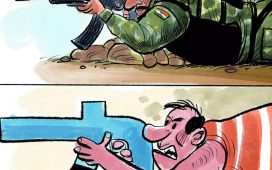
The key demands of the students are removal of the state’s director general of police Rajiv Singh and security advisor Kuldiep Singh, and handover of control of the unified command that controls the security apparatus in Manipur to the state government. ‘Go back central forces,’ has been their slogan.
Both Kuldiep and Rajiv Singh were appointed shortly after the outbreak of violent clashes between Kuki and Meitei groups last year. Kuldiep, a former CRPF DG, was widely reputed to be the union home minister’s pick. As security advisor, he’s head of unified command of state and central security forces including army, police, paramilitary forces and intelligence agencies operating in Manipur.
Manipur CM N Biren Singh of BJP had presented the governor with a memorandum demanding that control of unified command be handed over to him shortly before the outbreak of the student protests. There has lately been renewed pressure on the Centre to remove Singh as CM following the release of audio tapes that implicated him in the ongoing violence. His government has described the audio recordings as ‘doctored’.
The current escalation began following what was described as a ‘rocket attack’ on the residence of Manipur’s first CM M Koireng Singh on September 6, and concerns about the earlier use of drones by Kuki militants, allegedly to drop bombs.
Former Assam Rifles DG Pradeep Chandran Nair stated that the drones visible in videos were ‘small’ and the impact on ground was of bigger shells, and there were reasons to believe the latter couldn’t have been fired from those small drones. He also described the rockets used as being improvised, of indigenous make, and not of the kind used by modern armies. Bharatiya Janata Yuva Morcha, Manipur, has condemned this statement and warned that they would initiate legal proceedings against Nair.It is already a year and a half since fighting between the Meitei and Kuki communities began. Since then, it has not been clear what-beyond preserving status quo-GoI’s policy in the matter might be. But it is clear that no group in Manipur really wants status quo anymore.Kuki-Zo groups have been clearly stating for more than a year that there cannot be any going back to the way things were before the outbreak of violence. Meitei groups are unhappy with the unofficial division of the state and fear its Balkanisation. They are also not satisfied with the official administrative status quo and would very much like to see central security forces withdrawn or put under the command of the state government headed by Biren Singh, who happens to be a Meitei.
The other major community of Manipur, Nagas, have longstanding demands for a separate administration for the Naga-inhabited areas outside the control of Imphal. United Naga Council has now issued an ultimatum to Amit Shah to address their demands against the creation of seven new districts in Manipur in 2016, which is related to their overlapping territorial claims with Kuki groups.
The mess in Manipur risks becoming part of a much larger one as the junta running Myanmar has been losing control of its territory to ethnic rebel armies and pro-democracy forces in the ongoing civil war there. A redrawing of the map and constitution of Myanmar in the not-too-distant future is possible. The opposition National Unity government of Myanmar has already released plans for abrogating the current constitution and replacing it with a new one that would emphasise principles of federalism and democracy.
Western military support for this has not been forthcoming. But if that were to change, the result could be a proxy war involving China, Russia-Myanmar’s biggest arms supplier-the US and India. So, not just internal, but also external dilemmas for India threaten to coalesce in the crisis in Manipur.










